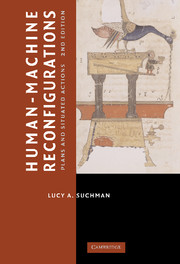Book contents
- Frontmatter
- Contents
- Acknowledgments
- Preface to the 2nd Edition
- Introduction
- 1 Readings and Responses
- 2 Preface to the 1st Edition
- 3 Introduction to the 1st Edition
- 4 Interactive Artifacts
- 5 Plans
- 6 Situated Actions
- 7 Communicative Resources
- 8 Case and Methods
- 9 Human–Machine Communication
- 10 Conclusion to the 1st Edition
- 11 Plans, Scripts, and Other Ordering Devices
- 12 Agencies at the Interface
- 13 Figuring the Human in AI and Robotics
- 14 Demystifications and Reenchantments of the Humanlike Machine
- 15 Reconfigurations
- References
- Index
14 - Demystifications and Reenchantments of the Humanlike Machine
Published online by Cambridge University Press: 05 June 2012
- Frontmatter
- Contents
- Acknowledgments
- Preface to the 2nd Edition
- Introduction
- 1 Readings and Responses
- 2 Preface to the 1st Edition
- 3 Introduction to the 1st Edition
- 4 Interactive Artifacts
- 5 Plans
- 6 Situated Actions
- 7 Communicative Resources
- 8 Case and Methods
- 9 Human–Machine Communication
- 10 Conclusion to the 1st Edition
- 11 Plans, Scripts, and Other Ordering Devices
- 12 Agencies at the Interface
- 13 Figuring the Human in AI and Robotics
- 14 Demystifications and Reenchantments of the Humanlike Machine
- 15 Reconfigurations
- References
- Index
Summary
Since the outset of the discipline, anthropology has been signally preoccupied with a series of problems to do with ostensibly peculiar relations between persons and ‘things’ which somehow ‘appear as’, or do duty as, persons.
(Gell 1998: 9)As this epigraph from Alfred Gell suggests, the distinction of humans and nonhumans marks a relation that has been extensively explored not only by anthropologists but also by their research subjects, among other ways through the fungibility of persons and things. My interest in this book is to contribute to explorations of these “peculiar relations” at a particular site of contemporary cultural imaginaries. that is, the computing sciences and arts. I have posited that the fascinations of artificial personhood for AI practitioners involve a kind of mimesis that works as a powerful disclosing agent for associated assumptions about the human. In this chapter I explore those assumptions through some specific encounters with contemporary humanlike machines, read through the lens of recent developments in the anthropology of science and technology and related fields. Capacities for action are recast in these writings from inherent capabilities to possibilities generated and reiterated through specific sociomaterial assemblages and enactments. These approaches shift the frame of reference from the autonomous human individual to arrangements that produce effective forms of agency within ramifying networks of social and material relations. Just how those networks are drawn and “cut” (Strathern 1996), and with what agential effects, is a practical, political, and aesthetic question, as well as a materially consequential one.
- Type
- Chapter
- Information
- Human-Machine ReconfigurationsPlans and Situated Actions, pp. 241 - 258Publisher: Cambridge University PressPrint publication year: 2006



